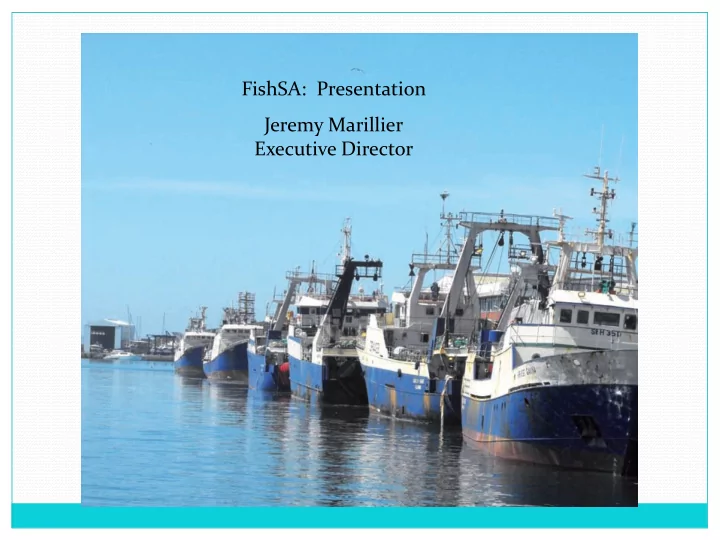

FishSA: Presentation Jeremy Marillier Executive Director
Economic Overview 600 000 tons harvested per year 22 fishing sectors – some optimally exploited and some over - exploited Wild capture fisheries contribute 0.2% to national GDP 1.4% to Western Cape GDP 27 000 jobs Capital intensive
Species profile The primary South African fisheries include § Demersal Fishery - Trawl & Longline, (hake and sole) § Pelagic Purse-Seine Fishery - Purse seine (Anchovy & Sardine) & Mid-water trawl (Horse mackerel § Rock Lobster Fishery – Trap fishing (West & South coast Rock Lobster) Additional sectors include § Mid-water Trawl (pelagic horse-mackerel) § Prawn Fishery (North-east coast) § Tuna Fishery (Pelagic Longline & Tuna Poleing) § Tuna, and Swordfish Longline § Squid Fishery § Artisanal Linefish § Abalone § Seaweed
Job creation Collectively, the deep sea trawling industry employs 7 050 people at sites in Saldanha Bay, Cape Town, Gansbaai, Mossel Bay and Port Elizabeth. Wages are negotiated at industry level and employees are offered a range of benefits including a variety of training opportunities and scope for career progression. Deepsea Trawl sustains 7050 direct jobs, of a total of approx 27 000 total jobs covering other sectors.
Investment opportunities Joint venture partnerships –recapitalisation of SA fishing fleet Direct equity investment or buy out options with SA partner. Using Cape Town as gateway for expansion into African fish markets Fishing Harbour upgrades.
Bilateral government initiatives SA needs good technical advisory support for developing Marine Spatial Legislation. Training and market development for Small scale fishermen. Tackling the poaching of fish resources- funding and expertise in developing an effective anti poaching strategy .
Economic empowerment Companies with interests in fishing were at the top of the Most Empowered Companies list JSE October 2016 African Equity Empowerment Investments, which topped the list of Most Empowered Companies, is parent company to Premier Fishing, which holds rights in the rock lobster fishery, the small pelagic fishery for sardine and anchovy, the squid fishery and the deep sea trawl and longline fisheries. In second place was South Africa’s biggest fishing company, the Oceana Group. Average % black shareholding in deepsea trawl= 62.36%
The Fishing Industry delivering on Government’s B-BBEE Strategy 70% 60% Average Black Shareholder % 60% 45% 50% 40% 35% 32.5% 30% 30% 30% 30% 30% 26% 20% 10% 0% 0% 2005 2010 2015 Agri-BEE Forestry Mining Construction Chartered Financial Integrated Accountancy Transport FISHING SECTOR OTHER SECTOR TARGETS DAFF PERFORMANCE REVIEW DTI JSE : 21% Black owned [2] 1. Chart: Sector Charter targets for Black Ownership. www.thedti.gov.za 2. Press Release. JSE 6 December 2012
Continuing on the transformation path Significant increase in black ownership of fishing rights since 2005 Ahead of black ownership targets in other sectors of the economy However: The objectives of Government’s B-BBEE strategy goes beyond just the increase in black ownership Define transformation targets.
Short to Medium term challenges Climate Change variability Marine Phosphate Mining/ oil and gas exploration-Fishing industry perceived as mature sunset industry compared to new growth sectors such as oil and gas etc. Compliance management- collectively need to harness a more effective anti poaching strategy General: need for business enabling environment Lack of policy certainty re transformation targets per sector Continued fragmentation of industry impacting job retention Current FRAP outcomes- concerning need for dialogue
Supply structure
Food security continued Larger-scale industrial fisheries contribute to the food security and nutrition , especially when they favour the wide commercialization of cheap, easily stored and transported (e.g. canned) nutritious pelagic fish such as sardine, pilchard, herring, anchovy or even tuna. As noted in relation to international fish trade, revenues generated by large-scale operations can also contribute indirectly to food security through employment creation where legislation to protect decent working conditions is in place.
Overview West Coast Rock Lobster Total Allowable catch per year: 1800 tons 250 commercial rights holders 825 small commercial rights holders 1500 small scale fishers R700 million revenue (US$60 million) 100% export; foreign exchange earnings
West Coast Rock Lobster Fishery South Africa Markets: § China § Hong Kong § Taiwan § Japan § USA
Overview: South Africa South African industry is dominated by the Western Cape, which accounts for more than 80% of domestic aquaculture produce. Aquaculture development in Southern Africa is hampered by a lack of investment finance. Local opportunities for training in aquaculture are few.
Western Cape The province is historically the centre of the fishing industry and is now also the centre of the aquaculture industry. Marine aquaculture operations are situated on the west and south coasts of the province. Fresh water aquaculture operations are situated inland, in the wine growing region of the province.
Major species: area based Aquaculture in the Western Cape is focused on the following high quality, high value species: § Abalone: west coast and south coast § Oysters: west coast § Mussels: west coast § Trout: inland
South African aquaculture products are of the highest quality. South African aquaculture complies with animal health and food safety regulations. The industry is free of disease. Most of the abalone is exported to the far East in frozen, live, canned and dried forms. Oysters are also increasingly exported to the far East. About 3000 people are employed in the aquaculture sector in the Western Cape.
Overview contnd
Far East import growth….
Maximising niche markets Prices for assorted farmed abalone products in South Africa have averaged US$30-50/kg over the last five years, with the value of total legal production totalling US$73 434 900 in 2015, projected to rise to US$135 million by 2020. South Africa’s current supply of farmed and wild abalone is 1660mt, and represents 2,8% of global supply.
Continued growth…
I look forward to hosting you in the beautiful Western Cape. Come and enjoy our exceptional aquaculture products. I would like to encourage research partnerships to deepen and expand the Western Cape aquaculture industry.
Recommend
More recommend